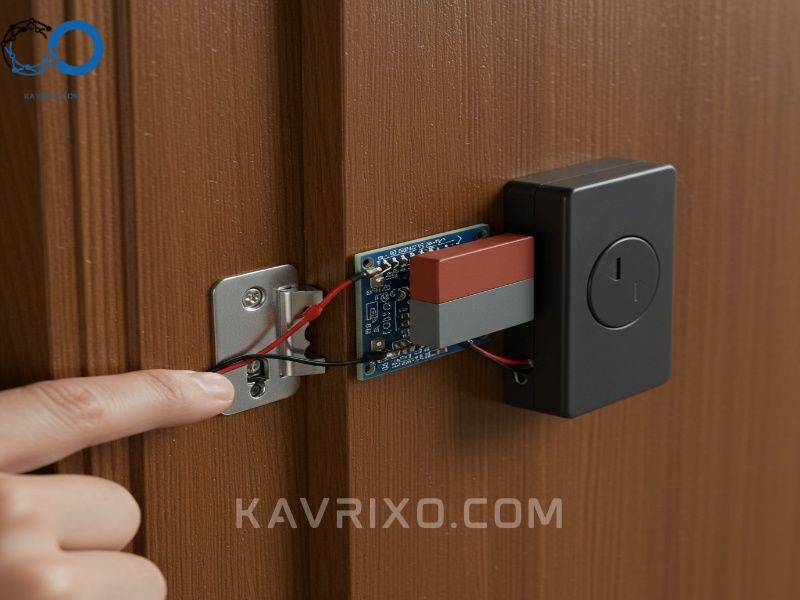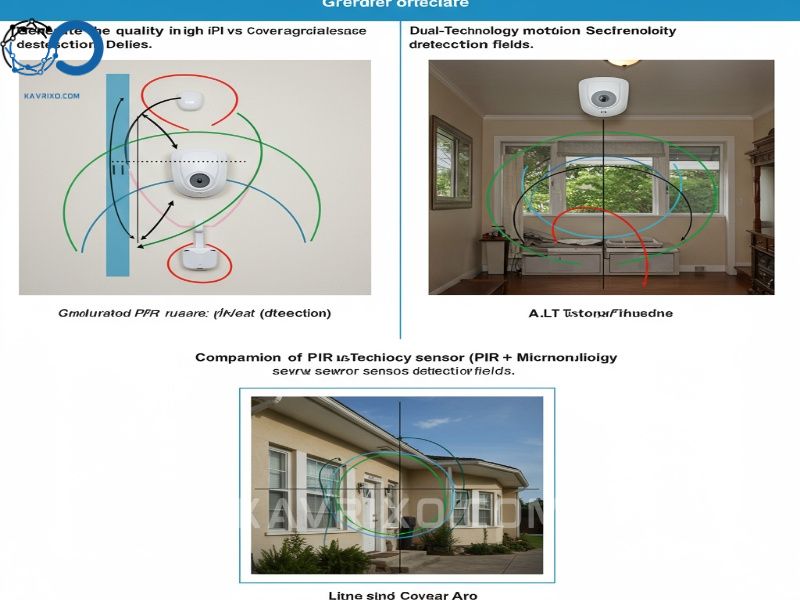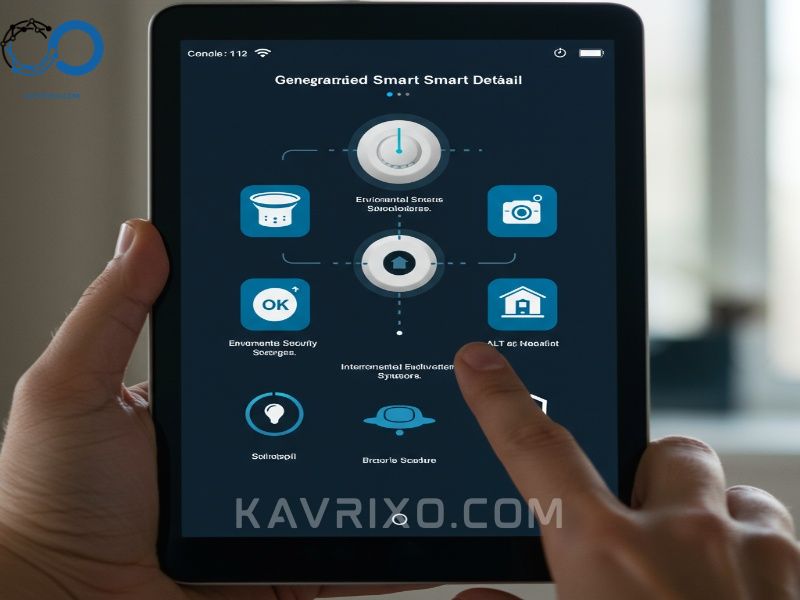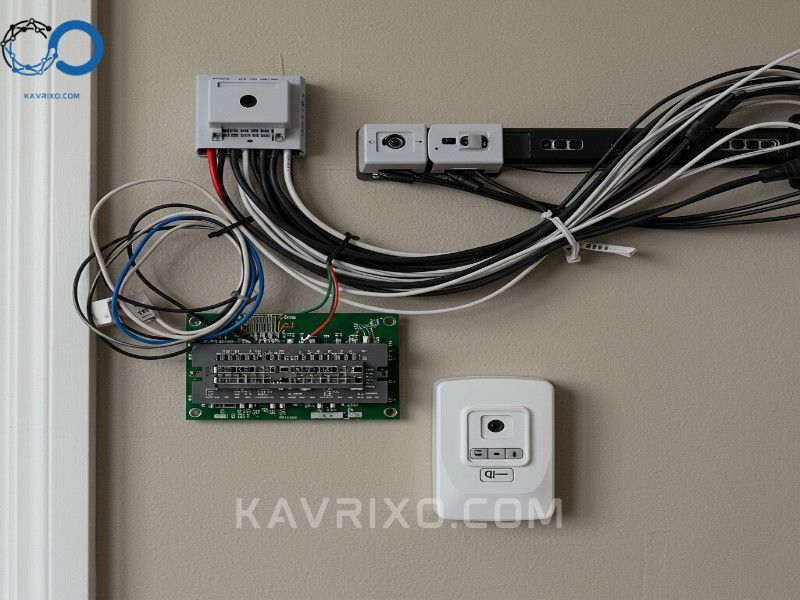In the evolving landscape of home protection, the reliability of your security setup no longer hinges solely on a loud siren or a single camera. Today, the true strength of any protective measure lies in the sophistication and coverage offered by its detection components. We are talking, of course, about security system sensors.
These small, often discreet devices are the eyes, ears, and nerves of your defense network. They provide the instantaneous detection necessary to thwart intruders, prevent disasters, and ultimately, safeguard your property and loved ones. Choosing the right collection of security sensors is perhaps the most critical decision when building or upgrading your system. This comprehensive guide will walk you through the various technologies available, helping you understand how these vital components work together to create an impenetrable shield around your home.
Contents
- 1 Why Security System Sensors Are the Foundation of Modern Protection
- 2 Essential Types of Security System Sensors for Intrusion Detection
- 3 Advanced Security Sensors: Layered Protection and Perimeter Control
- 4 Choosing the Right Technology: Wired vs. Wireless Security Sensors
- 5 Installation and Placement: Maximizing the Effectiveness of Security System Sensors
- 6 Integrating Security Sensors into the Smart Home Ecosystem
- 7 Investing in Comprehensive Security Sensors for True Peace of Mind
Why Security System Sensors Are the Foundation of Modern Protection
A security system is only as good as its ability to detect an abnormal event quickly. If an intruder enters, a fire starts, or a pipe bursts, the system needs to know about it immediately. Traditional alarms relied on very basic triggers, often failing due to poor placement or technological limitations. Modern systems, however, utilize advanced security system sensors that are designed for precision, reliability, and minimal false alarms.
Moving Beyond Simple Alarms
The shift in modern security is toward proactive awareness rather than reactive noise. When we talk about advanced home security system sensors, we are discussing devices that communicate instantly, differentiate between threats (like a burglar vs. a pet), and often integrate seamlessly with cameras and automation systems. This sophisticated communication minimizes response time, making the difference between a minor incident and a significant loss. Without robust and intelligently placed security sensors, your system is merely a collection of disconnected components.
The Core Function of Home Security System Sensors
At their core, all security system sensors perform one primary function: they monitor a specific environmental condition or perimeter and trigger an alert when that condition changes unexpectedly.
- Detection: Identifying an anomaly (e.g., a door opening, movement in a room, smoke density increasing).
- Signal Transmission: Sending an immediate alert signal to the main control panel.
- Action: The panel verifies the signal and initiates the appropriate response (sounding the alarm, notifying monitoring services, or triggering smart home actions).
Understanding this workflow is essential because it highlights why redundancy and coverage are non-negotiable when selecting your security sensors.

Essential Types of Security System Sensors for Intrusion Detection
The first line of defense focuses on detecting unauthorized entry. These are the security system sensors most people visualize when they think about home protection, and they form the necessary baseline for any effective system.
Door and Window Contact Sensors (The Basics)
Contact sensors are perhaps the most common type of security sensor. They operate on a simple yet effective principle: magnetic attraction.
How They Work: A contact sensor consists of two parts: a magnet attached to the moving element (the door or window) and a sensor unit (often containing a reed switch) attached to the frame. When the door or window is closed, the magnet keeps the circuit closed (or open, depending on the system design). When the door or window opens, the magnetic field is broken, triggering an immediate alarm signal.
Placement Strategy: While they are primarily placed on main entry points, maximizing their effectiveness requires placing them on all vulnerable access points, including basement windows, sliding doors, and secondary entryways. They are inexpensive, highly reliable, and essential for perimeter defense.
Passive Infrared (PIR) Motion Detectors
Motion detectors are crucial for interior protection, catching intruders who manage to bypass perimeter defenses. Among the various types of motion detection devices, PIR sensors are the industry standard.
How They Work: PIR sensors do not emit energy; instead, they passively detect infrared energy—or heat—radiating from objects. Since the human body emits a distinct infrared signature, a sudden change in the thermal patterns within a monitored zone (like a person walking across a room) triggers the alarm.
PIR vs. Dual-Technology Sensors: While standard PIR sensors are highly effective, they can sometimes be prone to false alarms caused by rapid temperature changes (like direct sunlight or forced air vents). To combat this, many professional systems utilize dual-technology (dual-tech) detectors, which combine PIR detection with microwave technology. Microwave sensors measure movement by emitting radio waves and analyzing reflected changes. A dual-tech sensor only triggers an alarm when both technologies detect a threat simultaneously, dramatically reducing false alarms while ensuring comprehensive coverage.

Glass Break Sensors (Acoustic and Shock)
Intruders often avoid opening doors or windows to prevent activating contact security sensors. Instead, they might smash the glass. Glass break sensors are designed specifically to detect this type of forced entry.
Acoustic Glass Break Sensors: These security sensors listen for the unique frequencies produced when glass is shattered. They are often placed on ceilings or walls and can cover multiple windows within line of sight, making them highly cost-effective. Modern acoustic sensors are sophisticated enough to distinguish between the sound of breaking glass and other loud noises (like dropped items or barking dogs).
Shock/Vibration Sensors: These are affixed directly to the window pane itself. They detect the specific vibration pattern caused by a sharp impact or the actual breaking of the glass. While they cover fewer windows individually, they offer earlier detection of tampering attempts before the glass is fully broken.
Advanced Security Sensors: Layered Protection and Perimeter Control
Beyond detecting unauthorized entry, a comprehensive security strategy utilizes security sensors to monitor environmental hazards and provide proactive, tamper-proof surveillance. These advanced components elevate a basic alarm system into a true safety network.
Environmental Monitoring Sensors (Smoke, CO, Water Leakage)
True home security extends far beyond burglar alarms. Environmental security sensors protect against the most common and damaging non-intrusion threats.
Smoke and Fire Detection
Modern smoke detectors are integrated directly into the security panel, allowing for instant notification to monitoring centers and emergency services, even if you are not home.
- Photoelectric Sensors: Excellent at detecting slow, smoldering fires, which produce large smoke particles.
- Ionization Sensors: Better for detecting fast, flaming fires, which produce smaller particles.
- Combination Sensors: Many advanced home security system sensors now combine both technologies (or use advanced multi-criteria detection) to provide the fastest possible warning for all fire types.
Carbon Monoxide (CO) Detection
CO is an odorless, colorless gas that is deadly. Integrated CO security sensors are vital. Unlike standard store-bought detectors, connected CO sensors immediately alert the security panel and monitoring center, ensuring that emergency services are dispatched even if the occupants are incapacitated.
Water Leakage and Freeze Sensors
Water damage is one of the most frequent and expensive insurance claims. Water leak security sensors are small probes placed in high-risk areas (basements, under sinks, near water heaters). They detect the presence of moisture and alert the homeowner instantly, allowing for rapid intervention before catastrophic flooding occurs. Freeze sensors monitor temperature and warn homeowners if temperatures drop below a critical threshold (usually around 40°F or 4°C), preventing burst pipes in cold climates.

Image and Video Verification Sensors (Integrated Cameras)
While cameras are often treated as a separate component, modern surveillance devices function heavily as high-tech security sensors. When integrated properly, they verify alarms instantly.
Video Verification: When a contact sensor or motion detector is triggered, the connected camera immediately records a clip and sends it to the monitoring center or the homeowner. This allows for rapid assessment of the threat, confirming whether the alarm is genuine (a burglar) or false (a family member forgetting the code). This verification significantly speeds up police response time, as confirmed alarms receive higher priority.
Smart Detection: Many cameras now use advanced AI and machine learning to act as their own security sensors, identifying specific objects like people, pets, or packages, and alerting users only to relevant activities.
Vibration and Shock Sensors (Advanced Tamper Detection)
These sophisticated security sensors are often used in high-security environments, but they are becoming increasingly popular for residential use, particularly in urban areas or homes with high-value items. They are designed to detect attempts to breach walls, safes, or specific displays. They monitor for specific vibration frequencies associated with tools like drills, sledgehammers, or heavy impacts, triggering an alert before the breach is completed.
Choosing the Right Technology: Wired vs. Wireless Security Sensors
When selecting security system sensors, a primary consideration is the connectivity method: wired or wireless. Both options have distinct advantages and limitations that impact installation, reliability, and cost.
The Convenience of Wireless Security Sensors
The vast majority of modern home security system sensors are wireless.
Advantages:
* Ease of Installation: Installation is typically DIY-friendly or requires minimal professional time, as there is no need to run wires through walls, which saves significantly on labor costs.
* Flexibility: Sensors can be easily moved or added if the layout of the home changes. This is ideal for renters or those planning future renovations.
* Aesthetics: Wireless security sensors are small, discreet, and blend easily into the home environment.
Disadvantages:
* Battery Dependence: They require regular battery replacement (though modern sensors boast battery lives measured in years).
* Potential for Interference: Wireless signals (RF, Z-Wave, Zigbee) can occasionally be jammed or suffer from interference in densely populated areas, though professional systems use frequency hopping to mitigate this risk.
The Reliability of Wired Systems
Wired security sensors are typically found in older or newly constructed, custom-designed homes where the wiring can be hidden within the walls.
Advantages:
* Maximum Reliability: Since they are directly connected to the panel, there is virtually zero risk of signal interference or battery failure.
* Power: Wired systems draw power directly from the panel, meaning the sensors themselves never require a battery change (though the central panel requires backup power).
Disadvantages:
* Installation Difficulty: Installation is complex, labor-intensive, and often requires opening walls or drilling, making it unsuitable for existing homes unless undergoing major renovation.
* Inflexibility: Moving or adding a sensor requires significant additional wiring work.

Power Management and Battery Life Considerations
If opting for wireless security sensors, battery life is a key metric. Look for systems that use standard, easy-to-replace batteries (like AA or CR123A) and feature low-battery warning indicators that notify both you and the monitoring company well in advance of failure. High-quality wireless sensors often achieve 3-5 years of battery life, reducing the maintenance burden significantly.
Understanding Signal Range and Interference
For larger homes or properties with detached structures (garages, sheds), ensure the wireless protocol used by your security system sensors (e.g., Z-Wave, proprietary RF) has sufficient range. Sometimes, signal extenders or repeaters are necessary to ensure 100% coverage and reliable communication back to the main hub.
Installation and Placement: Maximizing the Effectiveness of Security System Sensors
Even the most technologically advanced security sensors are useless if they are installed incorrectly. Strategic placement is the difference between a functional system and a truly protective system.
Strategic Placement of Motion Detectors
Motion sensors require careful consideration to prevent false alarms:
- Avoid Direct Heat Sources: Never point a PIR sensor directly at a window that receives direct sunlight, a heater, or an HVAC vent, as rapid temperature fluctuations can trigger the device.
- Corner Mounting: Placing sensors in corners maximizes the field of view, ensuring coverage across the entire room.
- Cross-Traffic Patterns: Place the sensor so that an intruder would walk across the detection beam rather than directly toward it. Walking across the pattern generates a stronger, more reliable signal.
Optimizing Environmental Sensor Locations
While intrusion security sensors focus on perimeter and interior access, environmental sensors must be placed where the hazard originates:
- Smoke/CO: Follow local fire codes, typically placing them outside sleeping areas, on every level of the home, and near potential fire sources (kitchen, furnace).
- Water Leak: Place directly on the floor near water heaters, sump pumps, washing machines, and under sinks.

Considerations for Pet Owners (Pet-Immune Security Sensors)
A common reason for false alarms in systems utilizing motion detectors is household pets. Fortunately, many modern PIR security system sensors are “pet-immune.”
These sensors are designed to ignore movement below a specific weight threshold (e.g., 40 lbs or 80 lbs). They achieve this by focusing their detection pattern higher off the floor. If you have large dogs, ensure you select sensors with a high weight tolerance and follow installation guidelines strictly, often requiring mounting them at a specific height (e.g., 7.5 feet) to ensure the pet remains below the primary detection zone.
Integrating Security Sensors into the Smart Home Ecosystem
The power of modern security sensors is truly realized when they integrate seamlessly with other smart home technologies. This connectivity allows for automated responses that go beyond simply sounding an alarm.
Automation and Response Protocols
Integration means your security sensors can communicate with lights, locks, and thermostats.
- Lights On: If a motion detector is tripped late at night, the system can automatically turn on all interior and exterior lights, startling the intruder and providing visual verification for cameras.
- Lock Down: In case of a verified alarm, the system can automatically lock all smart doors and garage entries.
- Emergency Egress: Conversely, if a smoke or CO sensor is triggered, the system can automatically unlock all doors, ensuring safe exit for occupants.
This level of responsive automation turns your collection of security sensors into a cohesive, intelligent defensive mechanism.

Professional Monitoring vs. Self-Monitoring
When selecting security sensors, you must decide how the alerts will be handled.
Professional Monitoring: In this model, every signal transmitted by your security sensors goes directly to a dedicated central station. Trained operators verify the alarm (often using video verification) and immediately dispatch police or fire services. This is the gold standard for protection, ensuring an immediate, professional response 24/7, regardless of your personal availability.
Self-Monitoring: Here, alerts from the security sensors go only to your smartphone. While this offers cost savings, the responsibility for verifying the threat and calling emergency services falls entirely on you. This approach is only advisable if you are confident you can respond immediately to every notification. For maximal protection, professional monitoring of robust security sensors is highly recommended.
Investing in Comprehensive Security Sensors for True Peace of Mind
Choosing the right array of security system sensors is an investment in safety, not just technology. The goal is to create multiple, overlapping layers of protection—from the perimeter contact sensors that guard your entry points, to the motion detectors that secure the interior, and the environmental monitors that safeguard against unseen dangers.
By understanding the distinct functions of PIR, dual-tech, acoustic, and environmental security sensors, you can tailor a system that perfectly matches the vulnerabilities and layout of your home. Whether you opt for the simplicity of wireless installation or the absolute reliability of a wired setup, remember that the quality, placement, and integration of your home security system sensors are the true determinants of your system’s effectiveness. Invest wisely, prioritize coverage, and enjoy the peace of mind that comes with knowing your property is truly protected.
